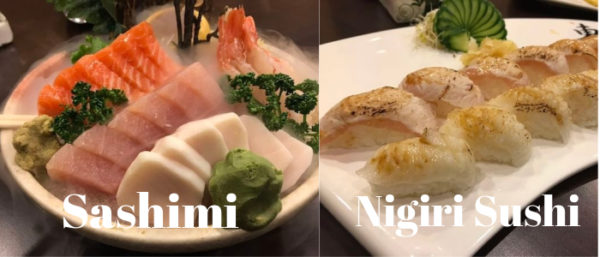We are reader supported. When you purchase through links on our site, we may earn an affiliate commission. Also, as an Amazon affiliate, we earn from qualifying purchases.
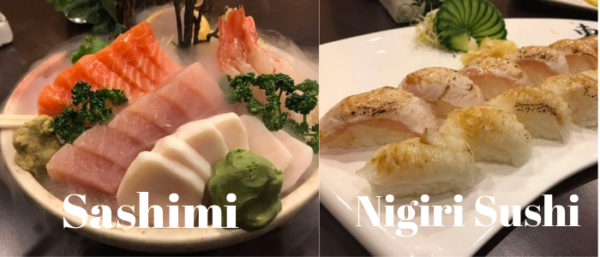
I have some a friend who loves sushi so much that he can’t live without having them at least 2-3 times a week. He was recently on a no carb diet in an attempt to lose weight and craved for his favorite cuisine really bad. He knows that I own a sushi blog so called me up to ask if there was a way to eat sushi minus the carb.
So, the question is – What is sushi without rice called? Many people refer sashimi as the sushi without rice as it consists of lone raw fish slice seasoned with soy sauce. Sashimi usually comprises of thin slices of raw fish or seafood.
Although most people will think ‘sashimi’ when talking about sushi without rice. However, it’s important to understand that there’s a huge difference between sushi and sashimi. While sashimi basically refers to slices of raw fish served alone, sushi is a delicious combination of rice, fish, veggies, seaweed, and so on.
If you are following a low-carb diet and still craving for sushi dinner, there are many other options than completely forgoing the rice. The Naruto roll wrapped in cucumber sheets is one classic example of riceless sushi. You may also choose healthier options like brown rice or quinoa instead of the glutinous white sushi rice.
Contents
Sashimi: A Popular Japanese Delicacy Without Rice
If you are looking to enjoy raw fish and other interesting fillings used in sushi without having to deal with the sushi rice, choose a sashimi instead. Sashimi refers to thinly sliced raw fish or seafood. It is usually served fresh or sashimi-grade.
Sashimi may typically comprise of raw fish such as tuna, salmon, octopus, horse mackerel, fatty tuna, sea urchin, and scallops. These slices are usually dressed with vinegar and other ingredients such as Nori, wasabi or daikon radish.
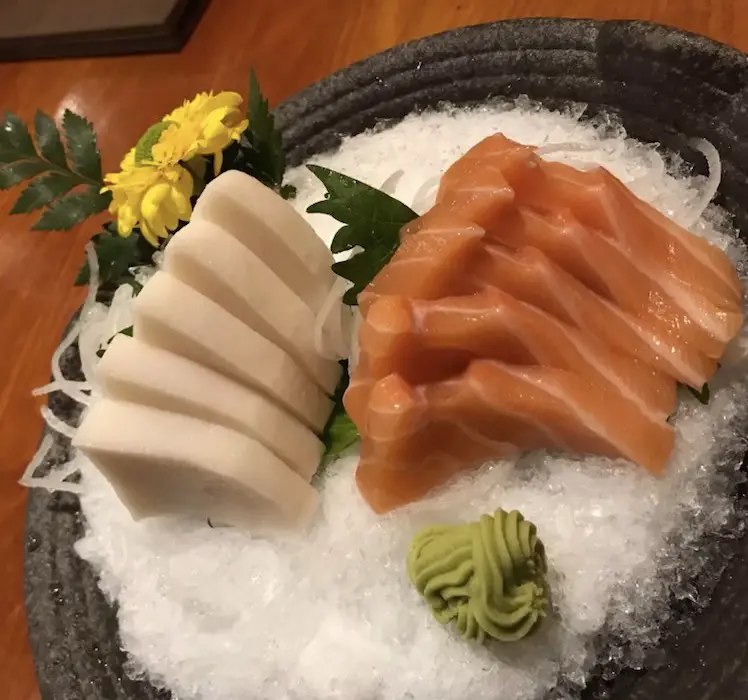
Sashimi is not the same as sushi because the former contains lone slices of meat, while the latter includes sushi rice and veggies too. To know the differences in detail, read this article – Difference Between Nigiri, Sashimi, Sushi Roll, Hand Roll, Gunkan Sushi
However, if you wish to avoid rice while dining out at a Japanese restaurant, you may choose to eat sashimi instead. You will find a plethora of raw fish and seafood selection in restaurants serving sashimi. They are usually presented arranged beautifully in a bed of grated daikon radish and garnished with sisho leaves.
Making Sushi A Diet-Friendly Meal
I know most people think sushi is far from being diet-friendly but it can quickly become a diet-buster with over 1,000 calories if you consume 2-3 rolls. If you still want to enjoy the indulgence without adding up so many calories with your meal, here’s what you need to know.
Most of the small-sized sushi rolls contain nearly 200-300 calories with every order. The large specialty rolls such as a tiger roll or rainbow sushi roll can go up to 400 to 500 calories, or even more. So, here are some ways to save calories and still enjoy your favorite food.
Naruto rolls are just like sushi rolls, just that they do not contain any sushi rice. They usually contain raw fish and a vegetable (usually avocado) wrapped in thin cucumber sheets.
You may use also nori sheets, rice paper or soy paper to wrap sushi rice filled with raw fish and optional veggies.
Temaki or hand roll is cone-shaped sushi containing seaweed filled with raw fish, veggies, little to no rice (preferably brown rice).
If you are dining out, ask your itamae or chef for a Naruto roll or sushi roll with cauliflower rice.
Naruto Roll Recipe
Ingredients
- 1 long Japanese cucumber
- Half avocado
- Sushi-grade raw salmon slices
- Instructions
Instructions
Peel the Japanese cucumber and use a vegetable slicer to make very thin slices. You may also use a Persian cucumber or American cucumber that has fewer seeds
Keep the bamboo mat like this on the kitchen table and cover it with a thin cling film. Now place the finely cut cucumber slices vertically so that the slices overlap each other
Cut the avocado into half, remove the pit and use a spoon to scoop out the flesh. Use a sharp knife to make thin slices of avocado.
Arrange the avocado slices horizontally on the cucumber peels in the same way as making sushi rolls.
Now make thin strips of salmon and arrange on the top of avocado slices.
Lift the bamboo mat and start rolling in the same way as you do in the case of sushi rolls. Gently press to give them a nice shape and let it stay wrapped in the cling film.
Now keep the roll inside the refrigerator for 10-15 minutes to let it take firm shape. When it is cooled, remove the cling film and use a sharp Japanese knife to make 6-8 pieces.
You can be creative with the fillings and add tuna slices or other vegetables as you desire. Then serve the sushi pieces with wasabi and pickled ginger.
Low Carb Sushi Rolls Without Rice (Recipe)
I know there may be some for whom a sushi roll is not the same without seaweed. If you feel similarly, I suggest trying to make this low carb sushi roll at home. It takes just 5 ingredients you can find easily and takes just 15 minutes to prepare a satisfying roll without rice.
Ingredients
- Nori sheets
- Smoked salmon (4 oz)
- 1/2 medium avocado
- 1/4 large red pepper
- 1/2 medium cucumber
Instructions
Take a sharp Japanese knife and cut the cucumber and red pepper into thin matchstick pieces of even sizes (about 1/2 cm wide).
Make sure you keep the same length as the narrow side of a Nori sheet. Now, cut the avocado and salmon into pieces of the same length but slightly wider
Place a bamboo mat on the kitchen table and put a Nori sheet over it. Now, arrange a piece of red pepper, salmon, cucumber, and avocado.
Start rolling the seaweed by lifting the bamboo mat and make sure the Nori sheets holds all the ingredients neatly inside.
When you are done rolling, seal the edges by slightly wetting the Nori sheet. Repeat the process until you use all the Nori sheets.
Cauliflower Rice May Be a Good Choice For Riceless Sushi
Interestingly, people who can’t have enough of sushi yet want to cut out the carbs have come up with numerous substitutes. One such substitute is cauliflower rice. However, it takes a lot of time and patience, so don’t expect to find them in a restaurant. You may make your own cauliflower rice at home.
To prepare delicious cauliflower rice, you need to chop the head of the vegetable coarsely and blend it in a food processor. Make sure you do not over blend as this will result in a paste instead of forming a rice-like texture.
When the cauliflower is blended in a way to resemble rice like consistency, you may place it in a microwave for nearly three minutes on high with a little olive oil. Remember to wrap it tightly in a microwave-safe cling wrap.
Season the freshly prepared cauliflower rice with a little salt and a tablespoon of rice vinegar to make it sticky. It is one of the most recommended options you can use to make your keto sushi rolls.
Bear in mind that cauliflower rice may not taste as authentic as sushi rice for creating rolls. It is difficult to put things together and make them stay in shape. However, if you are truly looking at cutting rice from your sushi, this is worth a try!
5 Tips To Help You Choose Smart Sushi Without Rice
Sushi is a light and flavorful meal that you can enjoy when you wish to break free from the usual carb-rich food. However, you must be careful because not all sushi rolls are created alike. Here are some simple tips to help you make a smarter sushi choice.
Choose the right appetizers
Forgoing rice in the sushi means that one complete roll will not make you as full as a traditional roll. To help you fill up without the need for rice, I would recommend that you order a green salad, broth-based soup, and seaweed salad as appetizers. Tell your chef to not add any dressing to the salad.
Sashimi is a great option
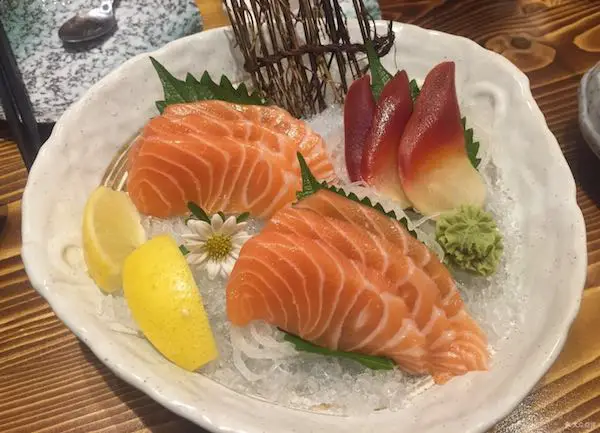
Anyone who wishes to savor the rich and fatty raw fish or seafood slices without rice should opt for sashimi. Although not technically a sushi, you savor the rich taste of tuna, salmon, or other specialties without having to eat it with sushi rice.
Order a couple of Naruto rolls
When you want to go riceless with sushi, Naruto rolls are your best bet (see recipe above). If you are looking to cut calories or are simply carb conscious, Naruto style rolls work miraculously. They are however tough to make, hence you will not always find it on the menu. Don’t be afraid to ask because sometimes a chef may accommodate your request even if it’s not on the menu.
Try a hand roll without sushi rice
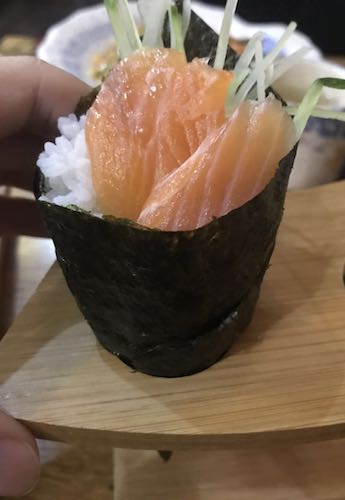
You can make mini temaki rolls with vegetable and raw fish strips as fillings. This can be a delicious and easy snack for those midday or late night cravings. As you don’t need to prepare rice, this can be ready in 15 minutes.
I would recommend that you also avoid the extravagant and rich cream cheese, tempura flakes, deep fried fish, and mayo. Some common words that indicate an extra load of calories are spicy, crunchy, and fried.
Eat in moderation
It is easy to lose control and overeat when you are dining out. However, I would suggest that you eat in moderation by ordering an appetizer and basic rolls to start with. If you share specialty rolls with a group, this may become disastrous.
Related Questions
Is it possible to make sushi without seaweed?
Yes, of course. If you are allergic to seaweed or simply don’t like the taste of it, you may use other delicious substitutes such as soy paper, rice paper, lettuce leaves and so on. Read this article for more information – 7 Ways To Make Sushi Without Seaweed.
Can I cook sushi without fish or seafood?
Absolutely. There are numerous vegan sushi options that can be savored without the need for fish or seafood. You can use fruits and veggies like spinach, avocado, cucumber, red pepper, sweet potato, spring onions, and so on. Tofu and shitake mushrooms are also popular options.
Can I still make California rolls without rice?
You can try making delicious California rolls with cauliflower rice, brown rice or quinoa. For the fillings, you can use imitation crab meat, cucumber, and avocado. This is the inside-out style of sushi where the seaweed is hidden inside the outer layer.
See Also:
Do I Need To Cook Tuna For Sushi?
Does Sushi Have Egg?

